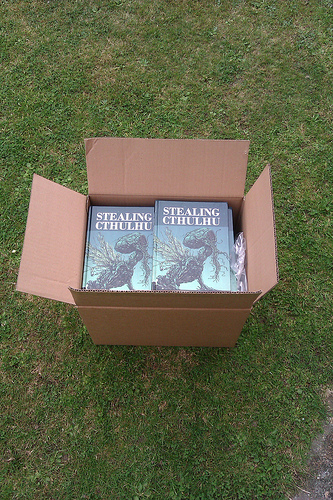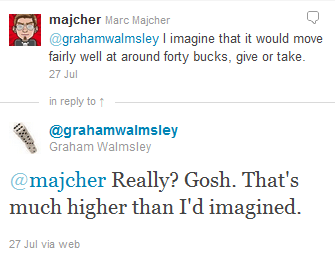More specifically, this question – again from Twitter – was:
So, how much should Graham charge for Stealing Cthulhu?
Here is the picture he links to:
Books are a good pricing puzzle because they combine two conflicting factors:
- The value they create is usually very high. A good fiction book will provide 10-50 hours of escapist entertainment, and the pleasure of the memories and discussions you can have afterwards. A good non-fiction book, depending on its subject matter, could generate business value of thousands or occasionally millions of pounds. So there should be opportunities to charge lots of money to reflect how much it’s worth to the customer. This particular book is perhaps somewhere in between those two scenarios.
- Books are seen as a commodity with very strong price anchors. Book buyers – perhaps wrongly – often see one book as a substitute for another. If you want to buy the latest James Ellroy book but it costs £50, you may seek out an alternative writer of deep-South thrillers instead. As much as I may try to persuade you that there’s nobody like James Ellroy, and the alternative is an inferior substitute, most consumers simply feel that it’s wrong to pay £50 for a novel, and they won’t do it.
The economic name for this is that books generate a very high consumer surplus – the difference between the price you pay and the value you get from a product.
If you are a publisher, or a self-published/independent author, your job is to figure out how to capture a higher share of the value they create. To do this, there are three strategies which you can follow together.
The first is to create more perceived value for the customer.
The second is to dislodge the buyer from their anchor by reframing the product.
The third is to segment your customers so you don’t lose the low end, while still capturing a higher price from the top end.
First, value. Most customers do not get full value out of a book. Do they pay it the attention they should? Do they actually try out all the things you recommend in the book? Do they savour the world you’ve created or cook the recipes you’ve invented?
Stealing Cthulhu is about how to create roleplaying game scenarios based on HP Lovecraft stories, and includes a ruleset for such games. Graham wants to sell it at a convention, and will be selling it online after that. He has already ordered a limited edition which has been pre-sold to advance buyers, so he’ll want to take into account what they’ve already paid for.
Indeed, the advance orders already display quite a subtle pricing structure – it was presold on a site called Indiegogo, and the choices included a wide range of added-value options – from a regular copy of the book at $28, to an extra electronic copy that can be annotated at $50, to a limited edition at $65, right up to the $600 level where you can have the book dedicated to you.If Graham wants to preserve his advance for future books, he might keep in mind that those $28 buyers might expect newcomers, who did not make an advance commitment, to be charged more. For that matter, Graham may well want to charge them more, if he can get it (and I think he can). Some anecdotal evidence:
The readers who will get most value out of Stealing Cthulhu are game designers themselves, who will use its insights to help them create their own works later. These people are going to be making an investment of hundreds of pounds worth of time in their own games, and that time may be significantly more productive and satisfying if they absorb the lessons from Stealing Cthulhu. So this audience should be paying perhaps £200 or £500 for the book.
However, there is an audience of more casual readers and gamers – who may never get around to running a game based on the book, but might be Lovecraft fans or simply interested in the horror-fantasy genre – and who probably won’t be interested at that price. So how to differentiate between them? Why not offer a live online video seminar with Graham for the game designer and GM audience; either one-to-one consulting or a group seminar where people can get ideas not just from Graham but from each other. That would be worth a couple of hundred pounds. (one of the options for the pre-orders was a little like this – Graham would run a game for the buyer in person)
To ease the shock of shelling out a lump sum for that, it would be better to offer a Writers’ or Designers’ Programme over 3 to 5 months at £60/month, including a monthly seminar, a manual with writing advice and Lovecraftian source material, and a forum where writers can post their own work for critique by other informed reader/writers. Not only is this useful inspiration but for many people, it will provide exactly the structure they might need to get their work completed.
An intermediate version of this product could be a £20/month subscription which would include fresh material and – let’s say – a video or podcast recording of some of Graham’s own games.
This model has five advantages:
- It takes advantage of hyperbolic discounting; people feel less pain from a commitment to future spending than from current spending.
- It allows Graham to give the book away for “free” now – which is likely to attract a much larger immediate audience than any non-zero price – and collect the money later.
- It creates a relationship with the reader, allowing him to provide them with more value later and sell them other things in the future.
- It repositions the book away from just being a book to being an ongoing service – which people will naturally expect to pay more for.
- It creates an anchor effect, making the book on its own appear to be better value than if it were sold with no comparison.
As for immediate sales, the bundling principle is a good one. There is other merchandise mentioned on the pre-order site (postcards, game scenarios etc) which can be included in a premium priced version. Bundling makes the value of the pack harder to compare with alternatives; and even if few people buy the bundle, it again makes the standalone book appear better value.
So my ultimate recommendation – for the convention, and probably also for online orders afterwards – is:
- Subscription to a Cthulhu Game Designers’ club, £60/month – including a free copy of the limited edition, and a monthly live webinar
- Subscription to a Cthulhu Gamers’ club, £25/month – which includes a free copy of the book
- Bundle: the book, postcards, scenario, autographed note, and whatever other cheap stuff he can find at the convention to bundle in: $75 (the convention’s in the US)
- Book alone: $38
- Extra scenarios to add onto book: $18 each
That $38 for the book? That ties in a few little things: it’s about half of the $75; it’s $10 more than the online price; it positions the book as a higher quality offering in line with the $40 market; and it creates sufficient distance between the book and the individual scenarios to feel logical.
There’s one final consideration: competition. Books are a strange case, because there is no exact competition for a book – every one is unique. But readers will make comparisons with neighbouring options. Graham mentions that he will be selling the books on a stand belonging to a publisher called Pelgrane.
Pelgrane publishes lots of other books and game materials at a range of prices – mostly below the $40 level but a few up there. By pricing at the top end of the products that will be available on the stall, Graham will send two useful signals.
First, that the products are high quality. This will be useful not just at the convention itself, but in the future.
Second, that the subject matter of the book is special: it’s not just another sourcebook or ruleset, but a guide to storytelling – not just a utilitarian work but an artistic one. Thus it’s positioned in a new category, one level up from the books beside it.
A final note. Although I often recommend it, premium pricing isn’t always the right strategy. If you want to create and dominate a market segment, lower or at least mid-market pricing may well be the right approach (though you should usually offer premium options too). But in a niche market like this, setting a price that both demonstrates and captures high value is usually the optimal play.




Hi i got a Question! Recently i was ask todo Photographs for a Book for a Hotel(Very Welthy!) what includes the Hotel and Staff and Suppliers a Whole year around! prob 250-300 pages dont know how many pictures but the idea is food photographs, interior, landscape and potraits in all 4 season! Cos iam employer in the hotel i would not have to consider to charge travel cost. The Previous Book cost 27€ was sold by 35€ by 5000 pices! Please Help!
interesting! I think you need to consider:
what is this promotional opportunity worth to the hotel?
what alternatives do they have? e.g. what competition is there? Or do they already value your work so highly that they would not consider going elsewhere?
how can you offer them several choices in order to let them signal their willingness-to-pay by choosing one? e.g. can you offer to either just take the pictures, or also edit and lay them out in the book? How about if they want to retain copyright of the photos – or you could reduce the cost by keeping copyright and then you can sell them elsewhere, e.g. to a stock photo service.
I’m not sure of the right price without knowing more about the situation, but these are some of the things you can consider when making a proposal.